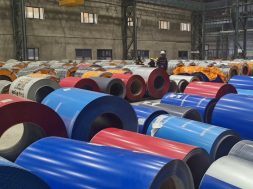Chemical Admixtures of Future: Extending Performance of Concrete [Apr 2012]
Chemical admixtures have long been known for the beneficial role they play in improving the engineering properties of concrete and mortar mixtures. Looking back over the past decades, the use of air entraining agents and superplasticisers can be considered among the major influences that have allowed extending the use of concrete for many diverse applications. Moreover, ACI 212.3R reports that chemical admixtures provide numerous benefits to concrete mixtures such as increasing compressive and flexural strengths at all ages, increasing durability through reduction in permeability, inhibiting corrosion of steel reinforcement, reducing shrinkage, altering setting and hardening rates, and increasing the slump and flow characteristics – all of which contribute to cost reductions associated with materials and placing, and increasing the service life of concrete. This discussion concerns the current and future needs of the concrete industry and how both newly introduced and future admixture technologies can make a favourable impact. Special attention is paid to new classes of chemical admixtures, which have begun to provide great value to the concrete industry such as the production and placement of self-consolidating concrete (SCC), allowing increased clay contents in aggregate sources, and reduced labour and improved performance of pervious concrete, and increased use of (supplementary cementitious materials (SCMs). Complimenting new chemical admixture technologies is the need for applicable standards that both protect and guide users as well as facilitate commercialisation.Future Trends and Challenges for Concrete Industry Continued improvements in admixture technology are closely related to trends in the concrete construction industry. Some of the major challenges and opportunities for the production, placement, and service life of concrete are as follows:• The need for increased production efficiency to allow more rapid use of structures• Shortage of qualified workers• Environmental pressures to minimise ‘carbon’ footprint through increased use of (a) supplementary cementitious materials (SCMs such as fly ash, slag, and microsilica); and (b) enabling easier production and placement of pervious concrete pavements• Use of concrete materials with increased variation in quality: (a) manufactured sands and aggregate crusher fines; and (b) recycled concrete components• Increased use of prediction models to more efficiently design structures for appropriate strength, workability, and service life• Ability to resist deterioration from ingress of aggressive materials and exposure to severe environments• Profit versus volume: (a) thin profits leave little margin for errors in construction; (b) and as much as 60 per cent of construction costs have resulted from litigation, which underscores the need for improved quality.
To meet these challenges, one can envision new chemical admixture products capable of further facilitating concrete production, placement, and durability. Some key opportunities include:• Water reducing and set accelerating chemical admixtures that exhibit similar performance across different cement/SCM compositions• A water reducer admixture capable of normal, mid-range, and high range water reduction• A simple test to alert concrete producers about a possible change in performance and potential cement-admixture incompatibilities when a new shipment of a concrete raw material is used• Chemical admixtures which overcome slow set and strength development when cement is replaced with high levels of SCMs • Chemical admixtures which facilitate the production and placement of self-consolidating concrete and pervious concrete mixtures• Integral curing chemical admixture to minimise cracking especially with high performance concrete mixtures• Air-entraining agents for predictable air contents and adequate air-void quality, which can overcome some 31 material, mixing, transport, and placement factors.
While estimating the time when some of the above chemical admixtures would ever become commercialised is beyond the scope of this discussion, one can look over the past decade to appreciate many innovations to concrete made possible by new chemical admixture. These include:• Polycarboxylate-based Superplasticizers• Mid-Range Water Reducers• Special Polycarboxylates for Self-Compacting Concrete• Shrinkage Reducing Admixtures• Structural Fibers• ASR Control Agents• Viscosity Modifying Admixtures• Hydration Control Agents• Slump Control Admixtures• Pervious Concrete Admixtures• Anti-freeze Admixture Systems• Surface Enhancing Admixtures.
Based on the successful launch of these as well as other products, there is optimism that the construction industry is ready to accept new technologies at a faster rate than in past years.
The broad range impact of chemical admixtures relative to the production and performance of concrete mixtures is represented in Figure 1. From the perspective of sustainability of concrete structures, chemical admixtures play a critical role in improving durability by helping mitigate numerous factors that can contribute to the deterioration of in-place concrete due to physical and chemical distresses (Fig. 1).For concrete producers, chemical admixtures enable a wide range of approaches and material options to achieve diverse design performance targets. Contractors particularly benefit from improved placement, setting, and finishability operations provided by chemical admixtures. Overall, chemical admixtures have become an essential component in concrete mixtures, helping to expand the concrete market by enhancing the economy and performance of concrete mixtures.
Innovations in Chemical Admixture TechnologyPolycarboxylates: Extending the limits of Concrete Performance The benefits of high range water reducing agents (also known as superplasticisers) to improve the mixing, placing, compaction, finishing, strength, and durability of concrete mixtures has become well established. To affect these procedures and properties, superplasticisers are used to either reduce large amounts of mixing water while maintaining an acceptable level of workability, or transform very low slump concrete into a flowing or self-levelling mixture. Reducing the water/cement ratio (W/C) can produce a densified paste structure and improve paste-to-aggregate bonding, which in turn, increases the strength development of concrete and enhances resistance to chemical attack [1-3]. For years, the concrete industry has been well served by cement dispersing technologies such as naphthalene and melamine formaldehyde condensate sulfonates (NSFC and MSFC, respectively). However, because of their inability to provide extended slump life coupled with wide variations in dosage to achieve consistent slump across different cement chemistries, the concrete industry has turned to polycarboxylate technology to not only address these shortcomings, but further improve key engineering properties such as self-consolidation without segregation, production of workable concrete at low w/c (<0.30), maintaining long slump life (up to two (2) hours without significant delay in set time, and improving surface finish.
The key attributes of polycarboxylate technology that promotes these performance features include [4]:• Low dosage: 20 per cent to 40 per cent of NSFC• Less sensitivity to addition time and cement chemistry• Predictable dose-slump response• Improved finishability; no ‘spotty set’• Less bleeding, more cohesive rheology• Minimal set extension when overdosed• Can be engineered many diverse applications such as SCC, high early strength concrete, increased use of SCMs.
An example of a relatively unexpected performance demonstrated by polycarboxylates involves an interesting synergy with calcium-based set accelerators.
The data, summarised in Table 1, was reported by a prestress concrete producer, who had been using a combination of a traditional ASTM C494 type A water reducer and a Type G NSFC/Lignin-based superplasticizer in a 390 kg/m3 concrete mix for prestress piles.Mix Design: Cement T-IIM – 390 kg/m3 ( 658 pcy); W/C – 0.32This remarkable strength difference, obtained by merely changing the superplasticizer type from an NSFC to polycarboxylate, has become an accepted benefit for those producing concrete with these additives, and has been the focus of two scientific publications [5, 6]. Interestingly, the strength difference does not seem to be associated with increased heat of hydration, but rather is related to a denser microstructure produced by the polycarboxylate-based admixture.
NSFC/WR
PC
PC, ml/100 kg
–
455
NSFC, ml/100 kg
1300
–
WR, ml/100 kg
130
–
CANI, l/m3
26.6
26.6
VR AEA, ml/100 kg
78
39
Slump. mm
75
115
Air, %
5.4
5.5
Initial set, hr:min
3:50
2:30
1-day strength,MPA
32.4
43.1The most common application of polycarboxylates is to adjust slump life with minimal impact on set time and early strength. Shown in Figure 1 are the slump retention profiles of three concrete mixtures dosed with three different polycarboxylates. PC1 is generally used for precast/prestress operations where mixing and placement times are relatively short, and extended slump life is not required. Conversely, PC4 is well suited for Ready-mix concrete applications, especially where there may be delays in placing the concrete or hot weather could elevate concrete temperatures. Note that even though the slump life with concrete admixed with PC4 maintains its original slump for 1:45 hr:min, the delay in initial set is minimal.
The use of polycarboxylates is expected to experience continued growth as more and more concrete producers realise these many benefits.
Polycarboxylates, used in conjunction with viscosity modifying admixtures (VMAs), are essential for the robust production, transport, and placement of self-consolidating concrete mixtures. Figure 2 illustrates the role of superplasticisers and VMAs in controlling two critical fluid properties, yield stress and viscosity, that control for both static and dynamic stability.
The ‘Air’ Challenge: Predictable Air EntrainmentAir-entrainment in concrete has been universally accepted and as a well-established means for significantly enhancing the ability of concrete to resist the potentially destructive effect of repeated cycles of freezing and thawing, as well as alter the workability and yield of cementitious mixtures. Air-entrainment should be mandatory when concrete is to be exposed to such harsh environments, particularly when chemical deicers are being used, as on pavements and bridge decks.
However, in practice, consistently entraining adequate air contents for freeze-thaw durable concrete can often be a challenge for concrete producers as some thirty (30) factors, grouped into the following categories, can easily alter the performance on commercial air-entraining agents:• Concreting materials• Production processes• Construction practices • Field conditions• Measurement Techniques.
While it is uncertain whether possible advancements in air-entraining agents may be able to reduce the impact of these factors, concrete producers are advised to maintain rigorous quality control and testing programs to anticipate how changes in materials and mixing processes may affect air entraining agent performance.
ASTM Standards for Chemical Admixtures The ASTM C09.23 subcommittee on chemical admixtures has recently managed several major efforts relative to standards:• The C494 Standard for Chemical Admixtures (C 494-10) now allows provisional acceptance of Types A, D, F, and G admixtures if certain alternate compressive strengths are met either at 28, 90, or 180 days. The earlier version of this standard required 1 year test data before any approval of an admixture could be considered. The alternate strengths were based on a rigorous statistical analysis of 100 official ASTM C 494 test reports obtained from five (5) admixture companies. The provisional acceptance will now allow quicker commercialisation of new technologies.• The C494 Standard includes a new Type S, Special Performance admixture specification, which applies to those admixtures that provide a desired performance characteristic other than reducing water content, and/or changing time of set. Type S admixtures should not have any adverse effect on fresh and hardened properties of concrete.• A new standard (C 1622-09) specifying the performance of cold weather admixture systems has been approved. This standard establishes the detailed performance requirements for a chemical admixture system (usually HRWR + accelerator) that must be met in order to product and place durable concrete when the concrete reaches a temperature of –5o C, before initial set is achieved.• New ASTM standards for shrinkage reducing admixtures and rheology controlling admixtures are in progress.
Probing Material Compatibility IssuesIn another significant development, ASTM sub-committee C09.48 Performance was been created to help provide simple predictive methods for use by concrete and concrete raw material producers. The initial focus of the task group has been to develop methods based on isothermal calorimetry and a modified ASTM C 359 Early stiffening of Mortar test, with the anticipation that these methods can pick up a change in some key property of a paste mixture, with and without chemical admixture, that will translate more or less to a change in both plastic and concrete properties. This sub-committee has recently published C1679, Practice for Measuring Hydration Kinetics of Hydraulic Cementitious Mixtures Using Isothermal Calorimetry, which is used for studying the reactivity or hydration kinetics of a binder system in any combination with other materials that can be done at different temperatures and mixing conditions. Figure 5 is an example where five shipments of cement from the same cement plant provided the same heat signature when tested by isothermal calorimetry in the absence of chemical admixtures, but exhibited significantly difference thermal patterns when admixed with a common ASTM C 494 Type A water reducer. The cements were submitted for evaluation in response to a reported variable set time problem.
The calorimetry data for the admixed paste predicts a significant difference in setting time of the concrete could result depending on which cement is used. These differences are most probably a function of the complex interaction between the cement’s aluminate content, the interground gypsum used to control flash set, and the chemical admixture.
Viscosity-modifying Admixtures and Manufactured SandsAggregate shape, texture, and grading have been known to have a significant effect on the rheological performance of fresh concrete. Moreover, while the optimisation of aggregate selection can provide both technical and economical benefits, the availability of materials and construction operations can often dictate the use and proportioning of certain aggregate sources, such as manufactured sands, which can adversely impact the rheology of cementitious mixtures. The use of certain chemical admixtures, such as viscosity modifying admixtures, have been found to often avoid the need to increase cement and water contents in order to overcome the loss of workability that can accompany aggregate sources which feature flat, elongated, angular, and rough particles. Figure 4 illustrates the effect of VMAs on reducing pump pressures that can occur with increased use of manufactured sands.
ConclusionsConsidering all the trends associated with the concrete construction industry, the use of chemical admixtures is expected to play an increasingly important role in terms of mixture design, rheology control to facilitate placing, and long term durability. Many new technologies such as polycarboxylate-based superplasticizers have dramatically improved both production efficiency and quality of concrete, thus gaining rapid acceptance by concrete producers. Many exciting challenges and opportunities lie ahead for the continuous evolution of concrete as a versatile and durable construction material. The increased development and rapid commercialisation of innovative chemical admixtures is expected to play a key role in the future of concrete.
REFERENCES1.T. STONE, S.L. SARKAR, AND H. UCHIKAWA, “The Influence of Cross-linked and NSF Superplasticizer on the Flow Properties of Blended Cements,” Fourth CANMET/ACI International Conference on Superplasticizers and Other Chemical Admixtures in Concrete, ACI Special Publication, SP-148, pp 153-175, 1994 (Editor: V.M. Malhotra).2.UCHIKAWA, H., HANEHARA, S. SHIRASAK, T. AND SAWAKI, D., “Effect of Admixture on Hydration of Cement, Adsorptive Behavior of Admixture and Fluidity and Setting of Fresh Cement Paste”, Cement and Concrete Research, Vol. 22, 1992, pp. 1115-1129.3.SARKAR, S.L. AND BAALBAKI, M., “The Influence of the Type of Cement on the Properties and Microstructure of High Performance Concrete”, Proceedings of the 9th International Congress on the Chemistry of Cement, New Delhi, 1992, Vol. IV, pp. 89-94. 4.JEKNAVORIAN, A.A., ROBERTS, L.R., JARDINE, L., KOYATA , H., DARWIN, D.C., “ Condensed Polyacrylic Acid-Aminated Polyether Polymers as Superplasticizers for Concrete,” Fifth CANMET/ACI Conference on Superplasticizers and Other Chemical Admixtures in Concrete, Venice 1997.5.JEKNAVORIAN, A.A., BERKE, N.S., CONNOLLY, J., AND PRESCOTT, J., “ Synergistic Interaction of Condensed Polyacrylic Acid-Aminated Polyether Superplasticizer with Calcium Salts,” Sixth CANMET/ACI Conference on Superplasticizers and Other Chemical Admixtures in Concrete, Nice 2000. 6.JEKNAVORIAN, A.A., PORTENEUVE, C., SCRIVENER, K.L., GALLUCCI, E., GAL, G., “Synergistic Interaction of Chemical Admixtures: Use of Microstructural Characterization to Explain Strength Development of Portland Cement Mortars and Concretes.” American Ceramic Society Meeting, Baltimore 2005.
Cookie Consent
We use cookies to personalize your experience. By continuing to visit this website you agree to our Terms & Conditions, Privacy Policy and Cookie Policy.









